"The answer could be simple, champagne is made from grapes. But the different transformations that punctuate the production of champagne completely change its composition, just like time. A metamorphosis that begins in the Champagne terroir and ends in the heart of a bottle of champagne.
Grapes, the first noble material of champagne
But regardless of which, the grapes grown on the chalky soils of the Marne Valley produce three major grape varieties: pinot noir (black grape), pinot meunier (black grape), and chardonnay (white grape).
All three represent more than 99% of the Champagne vineyard. They are cultivated in the 4 major Champagne regions: the Montagne de Reims, the Côte des Blancs, the Marne Valley and the Côte des Bar. Chardonnay is produced everywhere in Champagne but the most famous is on the Côte des Blancs. There are also forgotten grape varieties that are slowly coming back, such as Arbane, Petit Meslier, Pinot Blanc and Pinot Gris.

Carbon dioxide, it has to sparkle!
Another ingredient goes into the composition of champagne and not the least: carbon dioxide, source of bubbles and sparkle. It is the Champagne method that allowed the transformation of "still" wines like white wine, into sparkling wines.
After harvesting and pressing, the grapes undergo a first fermentation in stainless steel vats and sometimes in barrels. Under the action of yeasts, the sugars in the juice are transformed into alcohol and carbon dioxide. The future champagne is then bottled where it benefits from a resting time in the cellars. This is when living organisms transform the sugar into alcohol and carbon dioxide.
12.5 degrees of alcohol on the meter
Therefore, champagne also contains alcohol, about 12.5°. Its mission is to give it body and facilitate its conservation over time. It is mainly composed of ethanol.
Its presence ensures a nice softness to the champagne. Another detail, the alcohol content is identical or almost identical in all champagnes, whether they are Bruts or Demi-secs.
Sugar, but an average of 80 calories per flute
Another essential ingredient in champagne is sugar. It is naturally present in grapes, but is used in small quantities in the liqueur de tirage and the liqueur de dosage. The liqueur de tirage is composed of still wine, sugar and yeasts selected to activate the prise de mousse (fermentation in the bottle).
The dosage liqueur comes after disgorging (the act of removing the sediment contained in the neck of the bottle). Composed of wine and sugar, it will determine the type of wine that we wish to obtain, from the sweetest to the least sweet, from Extra brut to Brut to Demi sec.
- Brut nature otherwise known as “zero dosage”. Contains no added sugar and less than 3 grams of residual sugar per liter.
- Extra brut: between 0 and 6 grams of sugar per liter.
- Brut: less than 12 grams of sugar per liter. This is the most consumed champagne.
- Extra dry: between 12 and 17 grams of sugar per liter.
- Dry: between 17 and 32 grams of sugar per liter.
- Demi-sec: between 32 and 50 grams of sugar per liter. It goes perfectly with desserts.
- Le Doux: more than 50 grams of sugar per liter. This is the sweetest champagne.
Beyond what it is made of, champagne corresponds to a privileged tasting moment. You just have to admire its color on the surface of the glass to understand that this exceptional product will always retain a great deal of mystery.




